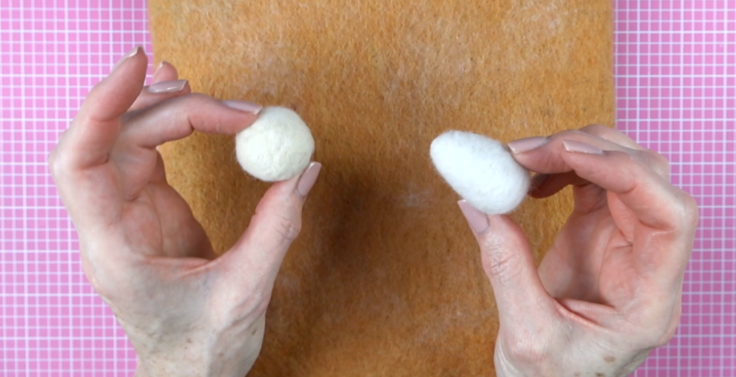Needle felting artists sometimes offer the opportunity to join a school or sign up for a course. Are they worth the money? It depends.
When compared to buying individual tutorials, a book, or watching free YouTube videos, paying for a course may feel expensive. But they can be a great value and help you get your needle felting off to a strong start. I purchased 4 courses over the last 4 years. 2 were amazing and 2 were not. Based on my experiences, here’s what you should consider before you sign up.
Does the format of the course fit your learning style?
How do you prefer to learn? Do you like to watch a video, view step-by-step photos with captions, read a book, or print a PDF that you can mark up with notes? Needle felting courses can include one or all of the above! Of the four I took, 2 were streaming video based (meaning you have an internet connection to watch), 1 had streaming videos but also included step-by-step photos with written instructions, and 1 was text based with a few short videos.
The video quality varied. Two were fantastic. One had dark videos. That made it difficult to see what the instructor was demonstrating. It was especially hard to distinguish wool with similar colors.
Three had a camera positioned over the top of the teacher’s worktable. The fourth course (with only a few videos) positioned a camera in front of a counter the instructor was working on. It included the counter, the instructor and a portion of the room in the video frame. Maybe they were trying to emulate an in-person experience where you’re standing in the room? That might work in theory but it made it impossible to see what the instructor was doing.
With a video course, check to see if the lessons are in a language you understand or can easily translate. The courses I took were in English. The videos did not have subtitles. The one that included video and text with step-by-step photos was the exception. That text could be translated with a tool like Google translate. The text and photos also allowed you to quickly check something versus having to watch the video again.
How many lessons and full projects are included?
I’m going to define a “lesson” as demonstrating a technique or a tip and a “full project” as a piece that is made start to finish. Each course included a different mix of these.
- 1 had 12 full projects. At the end of that course, you would complete 12 finished pieces.
- 1 had 26 lessons and 5 full projects.
- 1 had more than 40 lessons and 2 full projects. But the number of lessons was deceptive. The lessons were often short video clips of longer lessons within the course. This made navigating the course confusing. The intention was to allow you to choose your own adventure and hop around the content. But it made the lessons feel repetitive and I wasn’t sure what I had or had not seen already.
- 1 was an 8 week course with 7 full projects. The last week you were asked to create your own project using the techniques you learned.
How long will you have access to course content?
3 of the courses offered lifetime access to the content. 1 limited access to 16 weeks. After that, you lost access to the lessons and projects. I did not have time to complete all the projects during the 16 weeks. When I returned later, I was locked out of the course.
I’m sure that somewhere during the sign up process, this limited access was probably mentioned. But I don’t recall seeing it. It should have been called out more strongly so students (like me) aren’t disappointed. Make sure you understand how long you’ll have access so this doesn’t happen to you.
Will there be live calls?
If you want the ability to speak with the teacher or your fellow students, look for a course that offers live calls. 2 of the courses I took had a few live zoom calls. They were not part of the course lessons or projects but supplemented it. Students could submit questions via email prior to the calls. During the zoom calls, the instructors answered those questions or did demos related to them. They also took more questions live. The calls were recorded if you were unable to attend.
The zoom calls are a lovely bonus. One course continues to offer a short series of them once or twice a year. They coincide with a new batches of students joining, but old students are also welcome.
Is there a community with instructor support?
Speaking of that group feeling, the courses I took all included private Facebook groups. Unfortunately, I’m not on Facebook so I can’t comment on how helpful this was. If you’re looking for a course with a community, ask where it is hosted so you can determine whether you’ll be comfortable there.
One of the instructors also shared documents and images via Facebook. I was disappointed they they didn’t upload them to course.
How much will it cost?
The costs ranged from $250 – $97. The two courses I enjoyed the most were $199 and $97. They were both absolutely worth every penny I paid.
The most expensive course was the one I enjoyed the least and the one that did not offer lifetime access to the content. Price is not necessarily an indicator of quality or value.
Should you sign up?
Given my 50/50 success rate with needle felting courses or schools, I recommend doing research first. Answer the questions above. If it sounds good, here are 3 final tips to help inform your decision.
- Look for examples of student work, reviews, or comments. You can usually find them on the teacher’s social media accounts.
- Some teachers offer a free mini lesson in exchange for your email address. Others have individual tutorials you can purchase before you commit to the full course package. I took a free mini lesson for one of the courses and purchased a tutorial for another. They ended up being my two favorite courses!
- If the course feels like it’s a good fit, keep an eye out for discounts. Instructors may share special pricing on social media or through their newsletter. Follow their socials and join their email list and you might be able to save some money!
Last Updated on December 23, 2023




 Basic shapes in needle felting: your foundation for fluffy creations (FAQ #5 video)
Basic shapes in needle felting: your foundation for fluffy creations (FAQ #5 video)  Choosing the right needle felting mat: a comprehensive guide (FAQ #4 video)
Choosing the right needle felting mat: a comprehensive guide (FAQ #4 video)  Needle felting needles: a comprehensive guide (FAQ #3 video)
Needle felting needles: a comprehensive guide (FAQ #3 video)  Ditch the overwhelm: essential needle felting supplies for beginners (FAQ #2)
Ditch the overwhelm: essential needle felting supplies for beginners (FAQ #2)